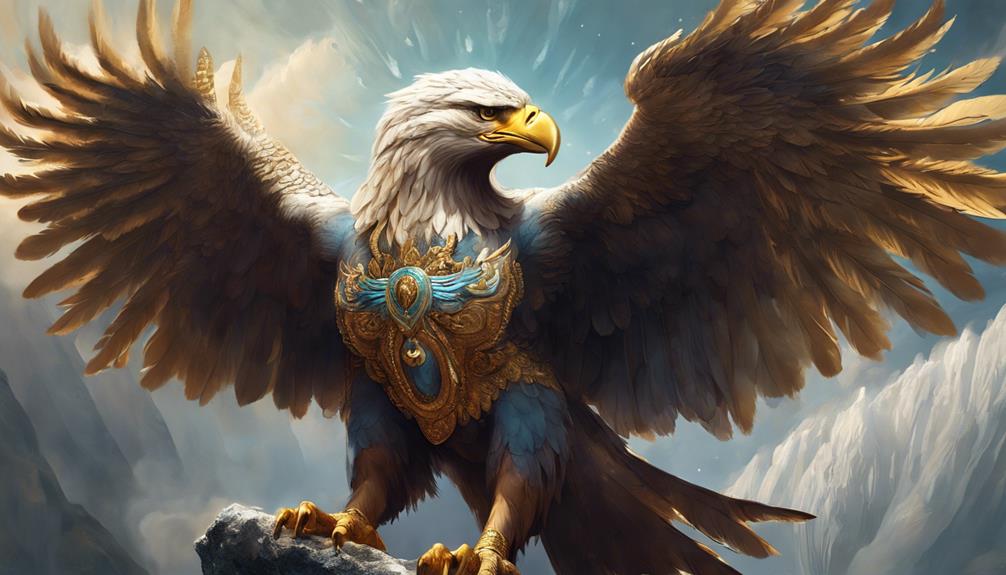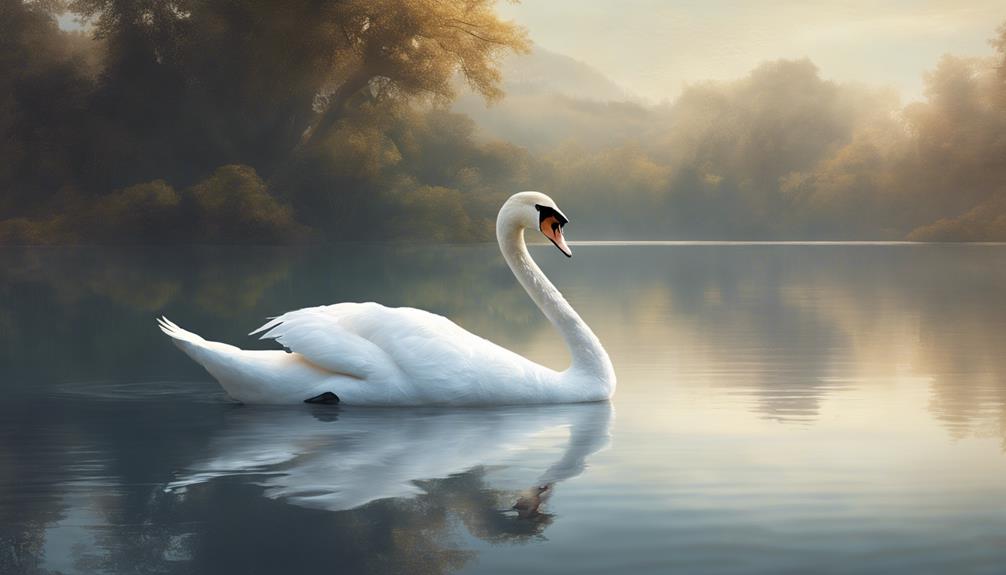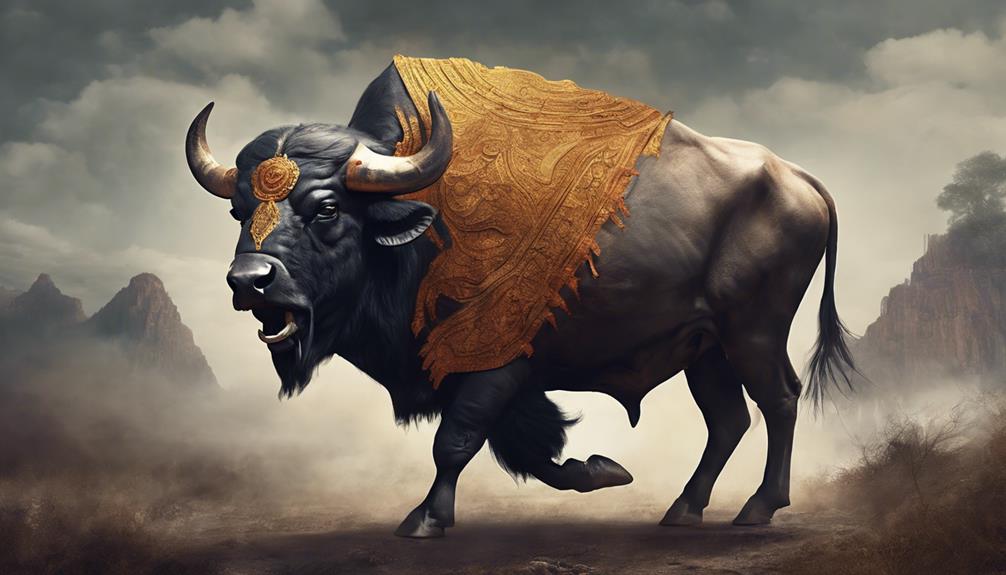Explore the intricate symbolism ingrained in the vehicles (Vahanas) of major Hindu deities, depicting profound themes such as wisdom, strength, grace, and power interwoven within Hindu mythology. From Goddess Lakshmi's wise owl to Lord Shiva's fearless lion, each Vahana embodies unique virtues reflecting the divine essence and roles of these deities in Hindu cosmology. Uncover the depth and significance behind these symbolic companions, revealing a rich tapestry of meanings waiting to be deciphered.
Table of Contents
Key Takeaways
- Goddess Lakshmi's Owl embodies wisdom and prosperity, signifying intellect and abundance.
- Lord Vishnu's Eagle symbolizes strength and protection, highlighting divine messenger qualities.
- Goddess Saraswati's Peacock represents grace and wisdom, emphasizing beauty and creativity.
- Goddess Parvati's Lion signifies strength and fearlessness, embodying courage and protection.
- Lord Brahma's Swan symbolizes purity and discernment, associated with spiritual depth and wisdom.
Lord Ganeshas Mouse
When you observe the symbolism behind Lord Ganesha's choice of a mouse as his vehicle, you uncover a profound representation of wisdom's ability to overcome obstacles. The cultural significance of this association lies in the mythological connection between the mouse and Lord Ganesha. In Hindu mythology, the mouse is often depicted as a creature that can gnaw through obstacles and challenges, symbolizing perseverance and determination. This aligns perfectly with Lord Ganesha's role as the remover of obstacles and the provider of wisdom.
The mouse, as Lord Ganesha's vahana, holds deep symbolic representation and spiritual significance. It signifies humility and the ability to adapt to any situation. Despite its small size, the mouse carries Lord Ganesha effortlessly, showcasing that wisdom and intellect can overcome any hindrance, regardless of its magnitude. The spiritual lesson here is that true wisdom empowers individuals to navigate life's challenges with grace and ease, much like how the mouse scurries through obstacles to carry Lord Ganesha.
Goddess Lakshmis Owl
The symbolic significance of Goddess Lakshmi's choice of an owl as her vehicle explores into the domain of wisdom and prosperity, embodying a profound connection between intellect and abundance. In Hindu mythology, the owl symbolizes foresight, intuition, and the ability to see what's hidden or in the dark. As the Goddess of wealth and prosperity, Lakshmi riding the owl signifies her divine connection to knowledge and the importance of wisdom in attaining and maintaining riches. The owl's nocturnal nature also represents the idea that wealth can come unexpectedly or from unseen sources, highlighting the mysterious ways in which abundance manifests in one's life.
Furthermore, the owl's mythological representation in Hinduism extends to providing spiritual guidance. Just as the owl can see in the dark, guiding Lakshmi through the shadows, it serves as a metaphor for illuminating the path to prosperity for her devotees. By choosing the owl as her vahana, Goddess Lakshmi emphasizes the necessity of a balanced approach that combines material wealth with intellectual acuity and spiritual insight.
Lord Vishnus Eagle

The majestic eagle, as Lord Vishnu's vehicle, embodies divine messenger symbolism, carrying messages between the celestial domains and Earth.
This powerful bird not only symbolizes strength and protection but also serves as a loyal and steadfast companion to Lord Vishnu, emphasizing the deity's omnipresence and watchful nature.
Through the imagery of the eagle, Lord Vishnu's role as a guardian and preserver of the universe is highlighted, showcasing the intricate symbolism behind Hindu deities' vehicles.
Divine Messenger Symbolism
Perched majestically atop Lord Vishnu's shoulder, his eagle companion symbolizes divine communication and swift action in Hindu mythology. Representing divine inspiration and spiritual guidance, the eagle serves as a messenger between Vishnu and the mortal world.
Known as Garuda, this majestic bird embodies the qualities of speed, precision, and clarity in delivering messages. In comparison to other divine messengers in Hindu mythology, such as Lord Shiva's bull Nandi or Lord Brahma's swan, Garuda stands out for his association with Vishnu's omnipresence and his role in swiftly carrying out tasks assigned by the deity.
The eagle's presence signifies the importance of clear communication and quick responses in the divine domain, reflecting Vishnu's proactive approach to maintaining balance and order in the universe.
Protective Companion Imagery
Serving as Lord Vishnu's steadfast companion, the eagle embodies a symbol of protection and guidance in Hindu mythology. The eagle, known as Garuda, is revered for its animal symbolism representing strength, speed, and keen perception.
In Hindu iconography, Garuda is depicted as a divine bird with a human body, symbolizing the harmonious union of the spiritual and earthly domains. As Lord Vishnu's vahana, or vehicle, Garuda carries deep spiritual significance, signifying the supreme deity's transcendence of worldly limitations and his role as a protector against evil forces.
The eagle's swift flight and sharp vision also symbolize the ability to soar above worldly distractions and perceive the truth with clarity, guiding devotees towards enlightenment and divine protection.
Goddess Saraswatis Peacock
Goddess Saraswati's majestic peacock embodies grace and wisdom through its vibrant plumage and regal demeanor. Saraswati, the Hindu goddess of knowledge, music, and the arts, is often depicted riding a white swan or seated on a lotus. However, her association with the peacock holds deep symbolic significance. The peacock is a symbol of beauty, immortality, and love in Hindu mythology. Its iridescent feathers represent the vibrant colors of creativity and the arts that Saraswati inspires in her devotees.
Saraswati's creativity is mirrored in the peacock's display of vibrant colors and intricate patterns. The peacock's ability to mesmerize with its plumage parallels Saraswati's role in inspiring creativity and intellectual pursuits. Additionally, the peacock's regal demeanor symbolizes wisdom and dignity, qualities that Saraswati embodies as the goddess of knowledge.
In comparison to other Hindu deities and their vahanas, Saraswati's choice of the peacock as her vehicle sets her apart as a deity of artistic expression and intellectual pursuits. The peacock's symbolism aligns perfectly with Saraswati's domains, making it a fitting companion for the goddess of wisdom and creativity.
Lord Shivas Bull

When exploring the symbolism of Hindu deities' vehicles, delving into Lord Shiva's Bull, Nandi, reveals profound layers of significance. Nandi symbolizes strength, power, and virility, embodying the raw force that underpins creation and destruction.
Unlike other divine vehicles, Nandi's unwavering devotion to Lord Shiva highlights a unique aspect of reverence and loyalty in Hindu mythology.
Symbolic Strength of Nandi
Nandi, the divine bull that serves as Lord Shiva's vehicle, embodies symbolic strength and unwavering loyalty in Hindu mythology. Nandi's role as Shiva's vahana symbolizes the immense power and resilience that the bull represents in Hindu culture.
The significance of Nandi goes beyond being just a mode of transportation for Lord Shiva; it reflects the idea of unwavering devotion and steadfastness. As the epitome of strength, Nandi is often depicted as a guardian and protector, showcasing the importance of inner fortitude and courage in facing life's challenges.
In comparison to other vahanas of Hindu deities, Nandi's symbolic representation highlights the importance of perseverance and dedication in the spiritual journey, making him a revered figure in Hindu mythology.
Nandis Devotional Significance
With a focus on Nandi's devotional significance in Hindu mythology, explore the profound symbolism behind Lord Shiva's loyal vehicle that embodies unwavering devotion and strength.
Nandi's devotion to Lord Shiva symbolizes unwavering loyalty and commitment in Hinduism. As the sacred bull and primary vehicle of Lord Shiva, Nandi represents the epitome of faith and obedience.
Nandi's spiritual significance lies in his ability to transcend earthly desires and embody pure devotion to the divine. This symbolism serves as a reminder of the importance of steadfast dedication and unwavering belief in the spiritual journey.
Through Nandi, devotees are encouraged to emulate his devotion towards Lord Shiva, fostering a deep connection with the divine and reinforcing the values of commitment and loyalty in their own spiritual practices.
Goddess Parvatis Lion
Goddess Parvati's lion, symbolizing strength and fearlessness, is a powerful representation of her divine presence and protection in Hindu mythology. The lion symbolism associated with Parvati's vehicle embodies various attributes that reflect her character and role in Hindu beliefs. Lions are recognized for their courage, leadership, and majestic demeanor, traits that parallel Parvati's persona as a fierce protector and nurturing mother figure.
The lion as Parvati's vahana also signifies her ability to vanquish evil forces and uphold righteousness. Just as the lion fearlessly confronts challenges, Parvati embodies resilience and determination in the face of adversity. Additionally, the lion's ferocity symbolizes Parvati's unwavering commitment to safeguarding her devotees and maintaining cosmic order.
Comparatively, when juxtaposed with other Hindu deities' vehicles, such as Lord Vishnu's Garuda or Lord Shiva's Nandi, Parvati's lion stands out for its association with strength and valor. The lion serves as a potent symbol of Parvati's protective and nurturing aspects, highlighting her significance as a revered goddess in Hindu mythology.
Lord Brahmas Swan

When contemplating Lord Brahma's Swan, it's essential to recognize the symbolism tied to this divine vehicle. The swan represents purity, grace, and discernment, embodying the ideals that Lord Brahma stands for.
Understanding the significance of swans in Hindu mythology can enrich your understanding of the deity and the principles he upholds.
Symbolism of Swans
Gracefully gliding across the celestial waters, Lord Brahma's Swan symbolizes purity, wisdom, and discernment in Hindu mythology. The swan's symbolism holds deep spiritual significance, representing the ability to discern between good and evil, truth and falsehood.
In Hindu mythology, the swan is associated with the idea of separating milk from water, symbolizing the ability to extract the essence from the outer appearance. This ability to discriminate is linked to Brahma's role as the creator, where wisdom and clarity are essential.
Mythological connections depict the swan as a creature of great beauty and grace, often depicted in artistic representations as a majestic bird embodying the qualities of purity and divine knowledge.
Significance in Worship
In Hindu worship practices, the significance of Lord Brahma's Swan as a symbol of purity, wisdom, and discernment is revered for its spiritual depth and representation of extracting essence from appearances. The ritual practices associated with worshipping Lord Brahma often involve invoking the qualities symbolized by the swan, such as purity of thoughts and actions, and the ability to discern truth from illusion.
Lord Indras Elephant
Indra's powerful mount, the elephant Airavata, symbolizes strength and stability in Hindu mythology. The elephant symbolism associated with Airavata goes beyond its physical might, representing wisdom, longevity, and royal power.
As the divine vehicle of Lord Indra, Airavata is known for its white color, which signifies purity and righteousness. This majestic creature is often depicted with multiple trunks, symbolizing its ability to overcome obstacles and carry the weight of the heavens.
In comparison to other Hindu deities' vahanas, such as Garuda or Nandi, Airavata stands out for its association with rain and thunderstorms, reflecting Indra's role as the god of weather and warfare. The elephant's presence as Indra's mount also highlights the importance of humility and loyalty in the pursuit of power.
Lord Yamas Buffalo

Lord Yama's Buffalo, known as his vahana, holds a unique symbolism in Hindu mythology that contrasts with the majestic elephant Airavata associated with Lord Indra. Yama's buffalo symbolism and cultural significance are deeply rooted in the Hindu belief system. While elephants are often seen as symbols of strength and royalty, the buffalo represents Yama's connection to the earth and mortality. The buffalo is a creature of labor and fertility, embodying the cycle of life, death, and rebirth.
Understanding Nandi's role as Lord Yama's vahana also reveals a spiritual connection between the deity and his mount. Nandi, the sacred bull, isn't merely a mode of transportation but a companion who guides Yama through the domains of existence. In Hindu tradition, the bull symbolizes dharma, righteousness, and loyalty. By riding on Nandi, Yama upholds the principles of justice and order as the god of death and the guardian of the underworld. The union between Yama and his buffalo signifies the balance between life and death, emphasizing the cyclical nature of existence.
Goddess Kalis Lion
Manifesting as the fierce Goddess Kali's formidable companion, the lion symbolizes power, ferocity, and divine protection, embodying the primal forces of destruction and creation within Hindu mythology. The lion symbolism in Hinduism is deeply rooted in the divine connection between Goddess Kali and this majestic beast. Known for her powerful imagery as a dark, fierce deity, Kali's choice of the lion as her vahana further accentuates her fierce and protective nature.
Comparatively, the lion as Goddess Kali's vahana can be seen as a parallel to other Hindu deities' vehicles like Lord Vishnu's Garuda. While Garuda represents speed and loyalty, the lion embodies strength and fearlessness. This symbolism highlights the diverse spectrum of traits depicted through various vahanas in Hindu mythology. The lion's presence as Goddess Kali's companion serves as a visual reminder of her ability to protect her devotees from harm and to destroy evil forces. Through this divine connection with the lion, Goddess Kali showcases her unwavering power and fierce determination in upholding righteousness.
Frequently Asked Questions
Why Does Lord Ganesha's Vahana, the Mouse, Symbolize Wisdom and Intelligence?
When exploring Lord Ganesha's vahana, the mouse, its symbolism of wisdom and intelligence becomes evident. The mouse's ability to navigate through intricate spaces parallels the journey of knowledge through the complexities of life.
What Significance Does the Owl Hold as Goddess Lakshmi's Vahana and How Does It Relate to Wealth and Prosperity?
The owl symbolism as Goddess Lakshmi's vahana goes beyond its nocturnal nature. It represents wisdom guiding wealth and prosperity. The significance lies in the owl's ability to see in darkness, mirroring Lakshmi's illumination of financial matters for devotees seeking abundance.
How Does Lord Vishnu's Vahana, the Eagle, Embody Strength and Protection in Hindu Mythology?
In Hindu mythology, Lord Vishnu's vahana, the eagle, symbolizes strength and protection. As his loyal companion, it embodies the power to soar above challenges and safeguard devotees, illustrating Vishnu's role as a guardian deity.
Why Is the Peacock Chosen as Goddess Saraswati's Vahana and How Does It Represent Creativity and Knowledge?
When considering the peacock symbolism for Saraswati, think about how it embodies creativity and knowledge. The peacock's beauty and vibrant display mirror Saraswati's inspiration, while its wisdom and intelligence complement the goddess's role as a source of enlightenment.
What Is the Symbolism Behind Lord Shiva's Vahana, the Bull, and Its Connection to Power and Destruction in Hindu Beliefs?
Lord Shiva's vahana, the bull, signifies power and destruction. Its strength and stability reflect Shiva's supreme control over the universe. The bull's connection to destruction emphasizes Shiva's role in transformation and renewal, embodying both creation and destruction.
Conclusion
To summarize, the symbolism behind the vehicles (vahanas) of major Hindu deities reveals a deeper connection between the divine beings and their attributes.
Each vehicle represents unique qualities that are associated with the deity they serve, showcasing a rich tapestry of symbolism and mythology in Hindu culture.
By understanding the significance of these vahanas, one can gain insight into the characteristics and powers of each deity, further enriching their spiritual understanding and appreciation of Hindu beliefs.